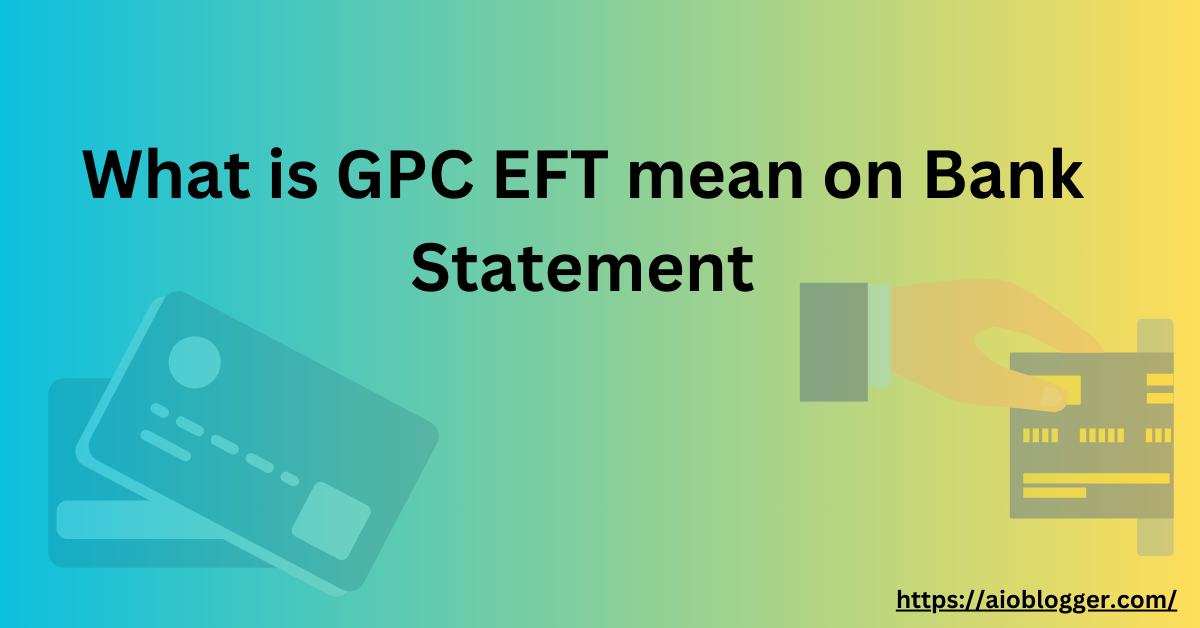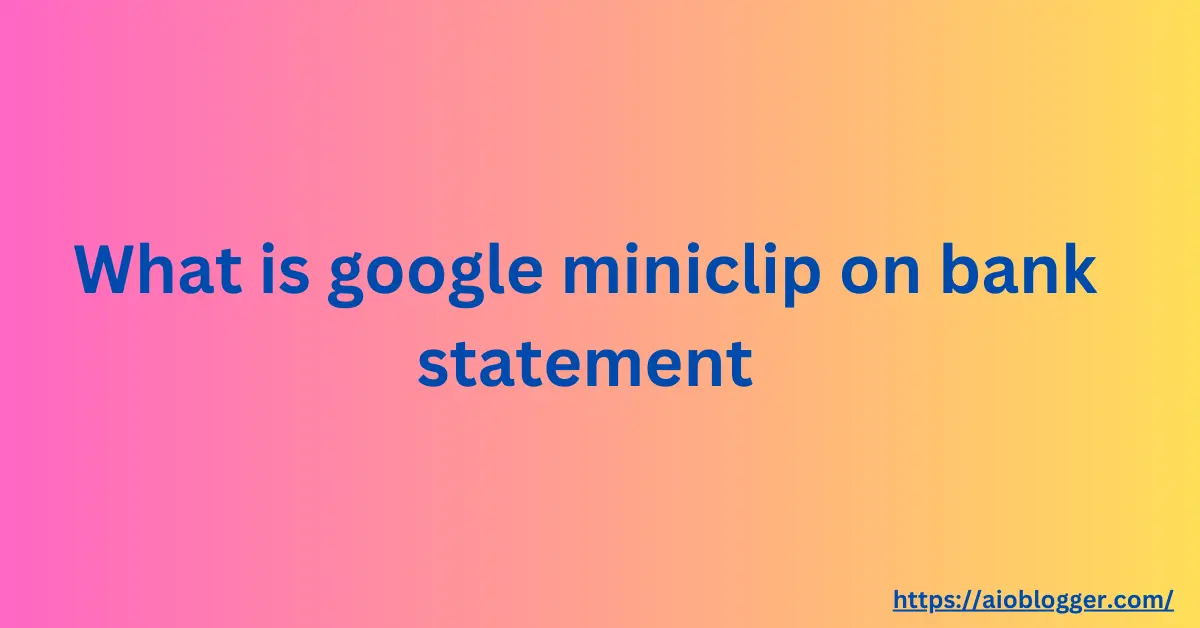You’re combing through your bank statement and see a mysterious charge, GPC EFT? What in the world is that? At first glance it looks like gibberish, but those letters actually mean something. EFT stands for electronic funds transfer, which is just a fancy way of saying money was moved from one account to another electronically. And GPC tells you which company initiated the transfer. But you’re still thinking, who the heck is GPC and why are they taking my money? Don’t worry, you’re not alone. Lots of people see odd transaction descriptions on their statements and have no clue what they mean or where the charges came from. Stick with me and I’ll walk you through exactly what GPC EFT means on your bank statement so you can relax knowing your money isn’t being stolen by some shady entity.
What Is GPC EFT?
GPC EFT stands for “Government Purchase Card Electronic Fund Transfer.” It’s a type of payment made with a government-issued credit card, which is given to government employees and authorized contractors to buy goods or services for the government.
When you see GPC EFT transactions on bank statements, they represent payments to vendors for items or services purchased.
While convenient, check your statements regularly to ensure there are no errors or unauthorized charges. You want to catch problems early in case of fraud or mistakes. If everything looks correct, gpc eft means your bills were paid on time without you lifting a finger. How’s that for easy?
How Does GPC EFT Appear on a Bank Statement?
You’ve probably seen those mysterious GPC EFT entries on your bank statements and wondered what they mean. GPC stands for “Government Purchase Card” and EFT means “electronic funds transfer”. Basically, it indicates a payment you made using your debit card.
When you use your debit card to pay for something, the money is instantly deducted from your bank account. The charge will show up on your statement as GPC EFT, along with details like the merchant name, date, and amount. These entries allow you to keep track of where
your money is going each month.
Some banks may use slightly different terms, like “POS debit” or “debit purchase”, but it means the same thing. As long as you see a debit for the amount you spent, usually within 1-3 business days, you know your purchase went through. Keep an eye out for these charges to make sure there aren’t any fraudulent uses of your card. If there are, contact your bank right away.

Benefits of Using GPC EFT for Bill Payments
Using EFT for bill payments through your bank offers several advantages. When you set up billers to receive electronic fund transfers (EFT) from your account, payments are made automatically on the due date. No more writing checks, buying stamps and rushing to the post office.
EFT payments are also very secure. Your account and routing numbers are encrypted during the transfer, reducing the risk of fraud or stolen account numbers. Payments through EFT are also more accurate since there is no chance of a lost or misdirected check. Your billers will receive the exact payment amount on time, every time.
For you, EFT means fewer worries and hassles when it comes to paying bills. Set it up once and you can put bill paying on autopilot, giving you more time to focus on other things. You’ll also have a clear record of all payments on your bank statements for easy record keeping and budgeting. Using EFT for bill pay is really a win-win, offering security, accuracy and convenience for both you and the companies you need to pay each month.
Handling GPC EFT Transactions
When you see “GPC EFT” on your bank statement, it stands for “Government Purchase Card electronic funds transfer.” This refers to electronic payments made from your account to a business, like utility bills, subscriptions, or merchant payments.##
To manage these transactions, check your statements regularly to ensure all charges are legitimate. If anything looks off, contact your bank right away. You should also let them know if your payment information like account numbers change.
For subscriptions, be sure to cancel as needed. Many companies automatically renew and charge you unless you cancel ahead of time. Staying on top of these types of payments will help avoid unwanted charges to your account.
Deciphering “GPC EFT” on Your Bank Statement: What Does It Mean?
When you check your bank statement, the letters “GPC EFT” next to a transaction mean that it was made using the electronic funds transfer system. EFT refers to the electronic transfer of money from one bank account to another, without the use of physical checks.
What Does “GPT” Stand For?
“GPT” stands for “global payments transaction.” It signifies that the EFT transaction on your statement was part of the automated clearing house (ACH) network. The ACH network is used for all kinds of fund transfers, including direct deposits, bill payments, and business-to- business payments.
Seeing “GPC EFT” on your statement means the transaction was processed automatically through the ACH network. Nothing is wrong and no action is needed – it’s simply the bank’s way of noting how the transaction was handled on their end. You can rest easy knowing your EFT payment or deposit went through as intended!
Electronic Funds Transfer (EFT) Meanin

EFT means that your bank electronically transferred funds from your account to another bank account. Instead of issuing a physical check, your bank simply transferred the funds electronically. This is a very common method for payments these days.
When you see “EFT” on your bank statement, it indicates that an electronic transfer of funds occurred, usually either a direct deposit into your account or a bill payment out of your account. The EFT provides details like the amount transferred, the account it went to or came from, and the company name. This allows you to easily reconcile the transaction with your records.
EFTs are a convenient way to send and receive funds. Payments can process faster since they don’t have to be mailed. EFT also eliminates the possibility of lost or stolen checks. As electronic banking has become more popular, EFT transactions have grown significantly. Most people today use EFT for direct deposits, bill payments, and account transfers.
What are Types of Electronic Funds Transfer (EFT)?
EFT refers to the electronic exchange of money between accounts. The most common types are:
Direct Deposit
This is when your employer deposits your paycheck directly into your bank account. Convenient and secure, direct deposit eliminates the need to deposit a physical paycheck.
Wire Transfers
Banks use wire transfers to electronically move money between accounts or to transfer funds to other financial institutions. Wire transfers are fast but often have high fees. They are commonly used for large transactions like buying a house.
ACH Payments
ACH stands for Automated Clearing House. ACH payments include direct deposit as well as automatic bill payments you’ve set up. They are efficient, low-cost alternatives to paper checks and are commonly used by businesses and consumers.
Online Banking
Through your bank’s website or mobile app, you can transfer money between your own accounts or send money to others. These online transfers are fast, free, and convenient. Just log in and follow the onscreen prompts to send or receive EFTs 24/7.
In summary, EFT refers to several types of electronic money transfers including direct deposit, wire transfers, ACH payments, and online banking. EFTs provide a fast, convenient alternative to paper checks for securely moving money between accounts.
How Does EFT (Electronics Fund Transfer) Work?
When you authorize an electronic funds transfer (EFT), you’re allowing funds to be electronically moved between accounts. Many people now use EFT for direct deposit of paychecks, automatic bill payments, and transferring money between accounts.
EFT works by using a network that connects different financial institutions. Once you provide account information like your account number and bank routing number, funds can be deposited or withdrawn electronically. Most EFT transactions are processed through an automated clearing house (ACH) network.
The key steps in an EFT transaction are:
- You provide account information to authorize the transaction. This is usually done by filling out a direct deposit form for your employer or entering account info on a biller’s website to set up auto-pay.
- The transaction information is submitted to the ACH, which forwards it to the appropriate banks.
- The banks verify the account information and either deposit or withdraw the funds as requested.
- The transaction is completed, with the details recorded on your monthly bank statement.
EFT transactions provide a fast, convenient way to move your money around electronically without having to withdraw and deposit physical cash. As long as you take normal security precautions, EFT can be a secure method for managing your funds.
What are 3 Examples of EFT?
EFT or electronic funds transfer refers to the electronic transfer of money from one bank account to another. There are a few common types of EFTs you may see on your bank statements:
Direct deposit: This is when your employer deposits your paycheck straight into your bank account. Instead of receiving a physical paycheck, the funds are transferred electronically.
Online bill pay: Using your bank’s website or app, you can pay bills electronically by scheduling payments to be sent from your account to the accounts of companies you owe. The payments are transferred electronically on the scheduled date.
ACH transfer: An ACH or automated clearing house transfer moves money between accounts at different banks. For example, if you want to transfer funds from your savings account at Bank A to your checking account at Bank B, an ACH transfer can accomplish this. electronically.

Recurring bill pay from your bank account
When you set up automatic bill payments (also called recurring payments or auto pay) from your bank account, it means the payment for things like utilities, loans, subscriptions, etc. will be deducted automatically on the due date each month. The amount and date are pre- authorized by you when you sign up for the service.
On your bank statements, these automatic payments will show up as “GPC EFT” which stands for “Government Purchase Card Electronic Funds Transfer.” The name of the company you’re paying, such as AT&T or Chase Auto Finance, will also be listed next to the transaction. Setting up auto bill pay means one less thing you have to remember each month and ensures your payments are made on time. You can set these up on the billing company’s website or through your bank’s bill pay service.
Just be sure to keep enough money in your account to cover all your automatic bill payments. If there are ever changes to the amount, date paid, or if you want to cancel a recurring payment, contact the billing company directly. They need advance notice, often 5 to 10 business days, to make any changes to your auto pay setup.
Can the vendor make payment by cheque rather than by way of electronic payment?
Of course, if you prefer, you can request that the vendor issue payment by cheque instead of an electronic funds transfer. Simply contact the vendor, either by phone, email, or in writing, and let them know you would like future payments made by cheque rather than EFT. Provide them with the name and mailing address where the cheque should be sent.
The vendor may require a written request for this change to ensure they have the correct payment details on file and to verify the request is legitimate. As long as you provide all the necessary information, the vendor should be able to easily switch your account to cheque
payments going forward. Be aware, however, that cheque payments typically take longer to process and can delay when funds become available in your account.
What are the different types of EFT payments?
EFT or electronic funds transfer refers to the electronic transfer of money between accounts. There are a few common types you may see on your bank statements:
Direct deposits are electronic payments made directly into your account, usually for things like paychecks, Social Security benefits, or tax refunds. Companies can send your funds straight to your account without the need for a physical check.
Wire transfers are electronic fund transfers between accounts, often used for large payments or international money transfers. Banks facilitate the secure transfer of funds from one account to another, domestically or internationally.
Bill payments are electronic payments you authorize to pay things like utility bills, credit cards, insurance premiums, etc. You provide the payee information to securely transfer the funds from your account to theirs on a recurring or one-time basis.
ACH or automated clearing house payments are also electronic fund transfers, commonly used for direct deposit of payroll and for bill payments. ACH payments are processed in batches and take a couple of days to clear, unlike wires which are sent individually in real-time. Understanding the types of EFTs on your statements can help give you a clear picture of the flow of funds in and out of your accounts each month. Let me know if you have any other questions!
Is Direct Debit an EFT?
Yes, direct debit is a type of electronic funds transfer or EFT. When you set up direct debit, you authorize a company or organization to electronically transfer funds from your bank account to pay for a product or service. The money is transferred directly from your account to the company’s account through an electronic network like ACH (Automated Clearing House).
Unlike writing checks or paying bills online where you initiate the payment, with direct debit the company pulls the funds from your account on a schedule you approve. While convenient, it’s important to keep good records of the companies you authorize for direct debit and the payment amounts in case of any errors. You should also let your bank know right away if you want to cancel or change a direct debit.
Direct debit allows for efficient automatic payments but still gives you control and oversight over the companies withdrawing money from your accounts. As with any EFT, direct debit is very secure as long as you take normal precautions like regularly monitoring statements and using unique passwords. By setting up direct debit for recurring household bills, you can simplify your payments and ensure everything is paid on time.
Benefits of Direct Debit as an EFT method
Direct Debit is a convenient electronic funds transfer (EFT) method for automatic bill payments. As a bank customer, you authorize companies you do regular business with, like utility providers or insurance companies, to automatically deduct payments from your account on a recurring basis.
Setting up Direct Debit for your routine bills has some nice perks. Payments are automatically deducted from your account on time so no late fees. You also don’t have to remember to schedule payments each month. Direct Debit is a secure method and payments can be stopped at any time if needed.
For companies, Direct Debit reduces costs since payments are electronic and automatic. This can often mean lower prices or rates for customers. It also cuts down on missed or late payments.
If managed responsibly, Direct Debit is a win-win. You gain convenience and peace of mind while companies gain efficiency and reliable
cash flow. An all-around streamlined process for handling those routine bills.
FAQS
GPC EFT means a General Purpose Transfer (Electronic Funds Transfer) from your bank account. It’s a way for funds to be moved directly between bank accounts electronically.
When you see a GPC EFT on your bank statement, it usually means an automatic bill payment was deducted from your account or that you authorized a direct transfer of funds to another account. For example, if you have your utility bills set up on auto-pay, the amount due each month will show up as a GPC EFT. Or if you transferred money from your savings to checking, that transaction would also appear as a GPC EFT.
Don’t worry, a GPC EFT is not a fraudulent transaction or bank error. It’s just an indication that funds were moved directly between accounts electronically with your prior permission and authorization. However, it’s always a good idea to double check any transactions on your bank statements that you don’t recognize. If you do see an unauthorized GPC EFT, contact your bank right away.
Conclusion
So there you have it. GPC EFT on your bank statement simply refers to a Government Purchase Card via electronic funds transfer. It’s the banking system’s way of noting that money was moved from one account to another electronically. While it doesn’t tell you anything specific about the payment, it at least provides the reassurance that the transaction happened securely and efficiently versus using outdated paper checks. The next time you spot GPC EFT on your statement, you’ll know it’s nothing to worry about, just a routine electronic payment like so many others you make every day. Mystery solved!



